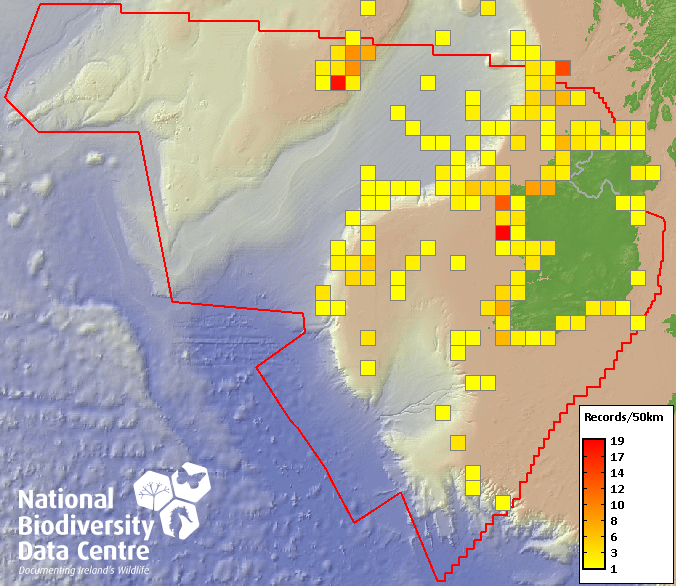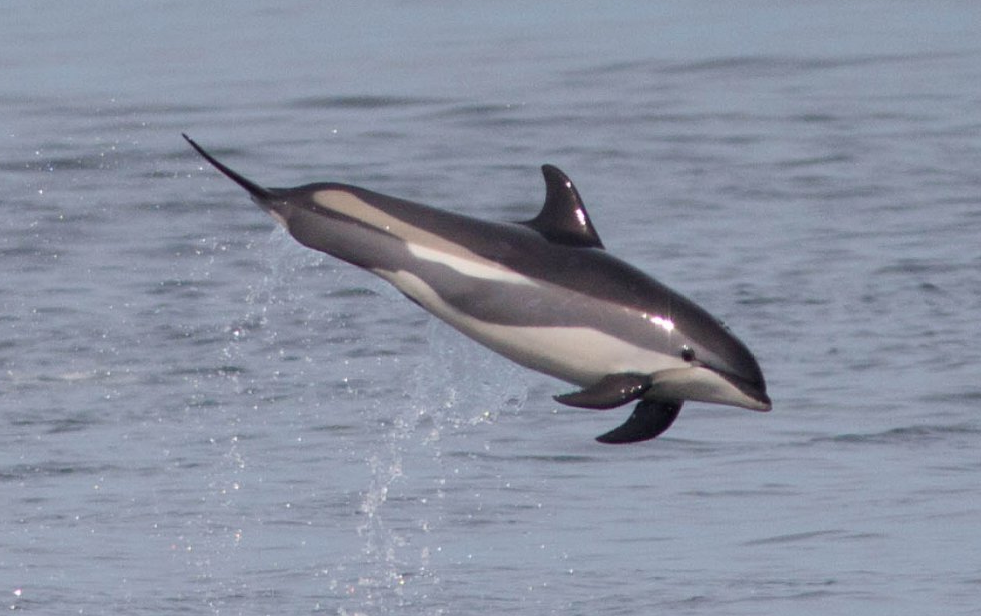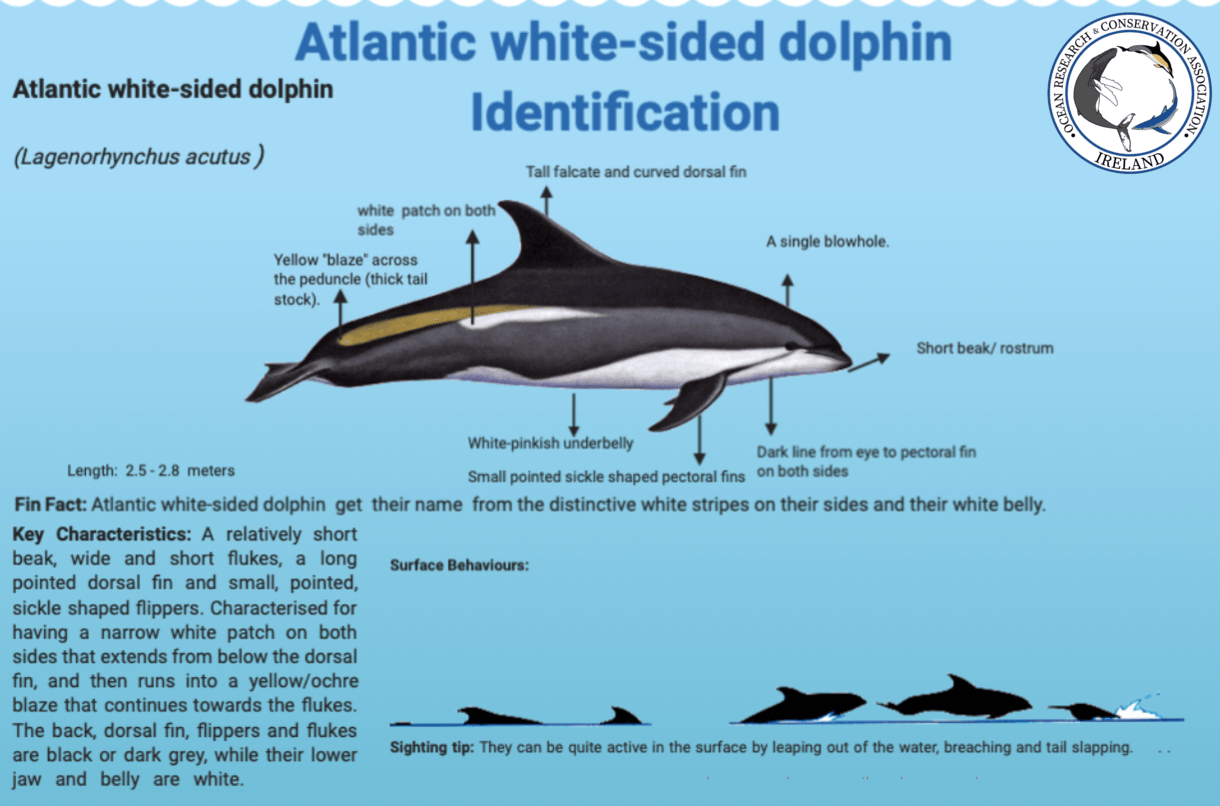Atlantic White-sided Dolphin
(Lagenorhynchus acutus)
Next Species ---->
<----Previous Species

Classification:
Kingdom:
Animalia
Phylum:
Chordata
Class:
Mammalia
Order:
Artiodactyla
Infraorder:
Cetacea
Family:
Delphinidae
Genus:
Lagenorhynchus
Species:
L. acutus
Get the Facts:
The Atlantic white-sided dolphin stands out for their impressive colour pattern. They also appear to be slightly larger compared to other oceanic dolphin species. Their name comes from the distinctive white stripes on their sides and their white belly.
Species Identification:
A male Atlantic white-sided dolphin can reach a maximum body length of approximately 270 cm and weigh 230 kg, while a female can be 250 cm long and weigh 180 kg. Their upper and lower jaw have 29 to 40 and 31 to 38 conical teeth respectively. They have a relatively short beak, wide and short flukes, a long pointed dorsal fin (this is why their specific name is acutus) and small, pointed, sickle shaped flippers. Atlantic white-sided dolphins are characterised for having a narrow white patch on both sides that extends from below the dorsal fin, and then runs into a yellow/ochre blaze that continues towards the flukes. The back, dorsal fin, flippers and flukes are black or dark grey, while their lower jaw and belly are white. They have a black eye ring that extends as a thin line to the upper jaw, and also from the eye ring a thin stripe extends to their external ear. They also have light grey stripes on both sides that connect their lower jaw to their flukes.
Diet:
Atlantic white-sided dolphins feed on a variety of fish, crustaceans and cephalopods such as squids. Depending on the season and location, they give preference to a certain type of food. This species commonly preferred prey are hake, herring, mackerel, gadid fishes, sand lances and different squid species. Atlantic white-sided dolphins are not deep divers; most of the dives last less than a minute but there has been observations that they can hold up their breath almost 5 minutes. They are “cooperative feeders” which means that they forage together as a group. They also are opportunistic feeders as they have been seen scavenging near fishing trawlers or during the forage of other whales species.
Habitat:
Atlantic white-sided dolphins have a limited distribution; they are usually found in the cold-temperate and low salinity waters from the north Atlantic Ocean. They tend to be in oceanic waters off the continental shelf at depths around 100m, but also in open oceanic waters, for this reason they are rarely seen close to the shores. There are indications that their habitat shifts due to changes in the distribution of prey species.
Behaviour:
Atlantic white-sided dolphins seem to be pretty social species though still little is known about their social behaviour. They often associate with other cetacean species such as fin, humpback and pilot whales, and also form mixed pods with other dolphin species. They can be quite active in the surface by leaping out of the water, breaching and tail slapping. Occasionally, adults will bow ride in front of vessels but it has also been observed that some of them move away from the vessels. Their most common pod size is between 2 to 60 individuals, though is not uncommon to see groups larger than 500 dolphins. It has been observed cooperative feeding among them, and it seems that small groups are formed for feeding while larger groups for travelling.
Social Structure:
Studies indicate that there is no evidence of kinship relation between individual in a group. A study suggest that alloparenting (when one individual provides parental care towards offspring that are not their own) can occur in groups of Atlantic white-sided dolphins, however this needs to be further studied. Males usually travel in small groups called bachelor pods and females, calves and juveniles in a group called maternal pods. Calves will usually stay in the mother’s pod until they approximately 3 to 5 years old.
Reproduction:
Atlantic white-sided dolphins become sexually mature at age 7 to 11, some females have been reported to be sexually mature at age 15. The gestation period lasts 10 to 12 months and the calve births occurs mainly during summer months (April-September). When born, calves are around 120 cm long and weigh 25 kg. The lactation period lasts about 18 months, or until they can survive on their own. Females have a calf every other year.
Vocalisations:
Atlantic white-sided dolphins produce different vocalisations for communication and echolocation. They mainly produce squeals, whistles, clicks and buzzes. Studies have found out that clicks are the dominant sound produced by this species, and it increases during socialisation.
Lifespan:
The maximum reported lifespan for males is 22 years and 27 years for females.
Global Distribution:
Atlantic white-sided dolphins are mainly found in the north Atlantic Ocean and their range extends from 35 to 80 N of the equator. In the Northeast Atlantic, they have been spotted during summer months in Cape Cod (U.S.A), the Gulf of Maine, the Bay of Fundy, Newfoundland, southern Labrador, Nova Scotia, New England and the Gulf of St. Lawrence. In the Eastern Atlantic, they have been observed in East Greenland, Iceland, the British Isles, western Norway and the Faroe Islands. There are no recorded sightings in the Baltic Sea.
Population Status:
Atlantic white-sided dolphins are abundant across their range, however it has been difficult for researchers to estimate properly their population. The estimated population is between 100.775 and 146.363 dolphins. In the UK and the North Sea, the most recent abundance estimate is 15.510 dolphins. This species is listed in the IUCN as “Least Concern (LC)”.
Threats to Survival:
Atlantic white-sided dolphins have been hunted in a small scale for subsistence purposes in Norway, Greenland, Canada and the Faroe Islands. Though there is no assessment that hunting represents a potential threat to their population. This species can become vulnerable to bycatch, especially because they are more exposed when scavenging near trawlers. Caught dolphins have been reported in the southwest coast of Ireland due to Dutch pelagic trawl fishery. Despite the threat of entanglement, this species, due to their offshore nature, are less vulnerable to bycatch than other dolphin species. Like other marine mammals, Atlantic white-sided dolphins can be affected by noise pollution, habitat degradation, chemical pollution such as heavy metals or persistent organic pollutants (POPs), plastics and climate change. Nonetheless, all of them must be studied further. Besides humans, Atlantic- white-sided dolphins are occasionally attacked by orcas or sharks.






